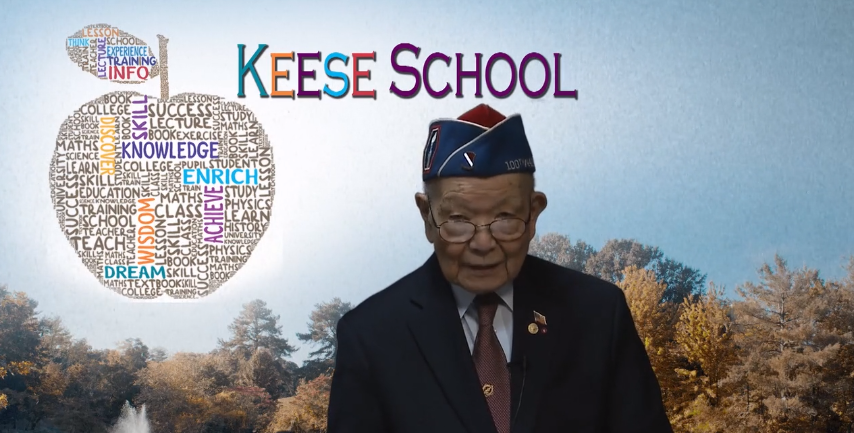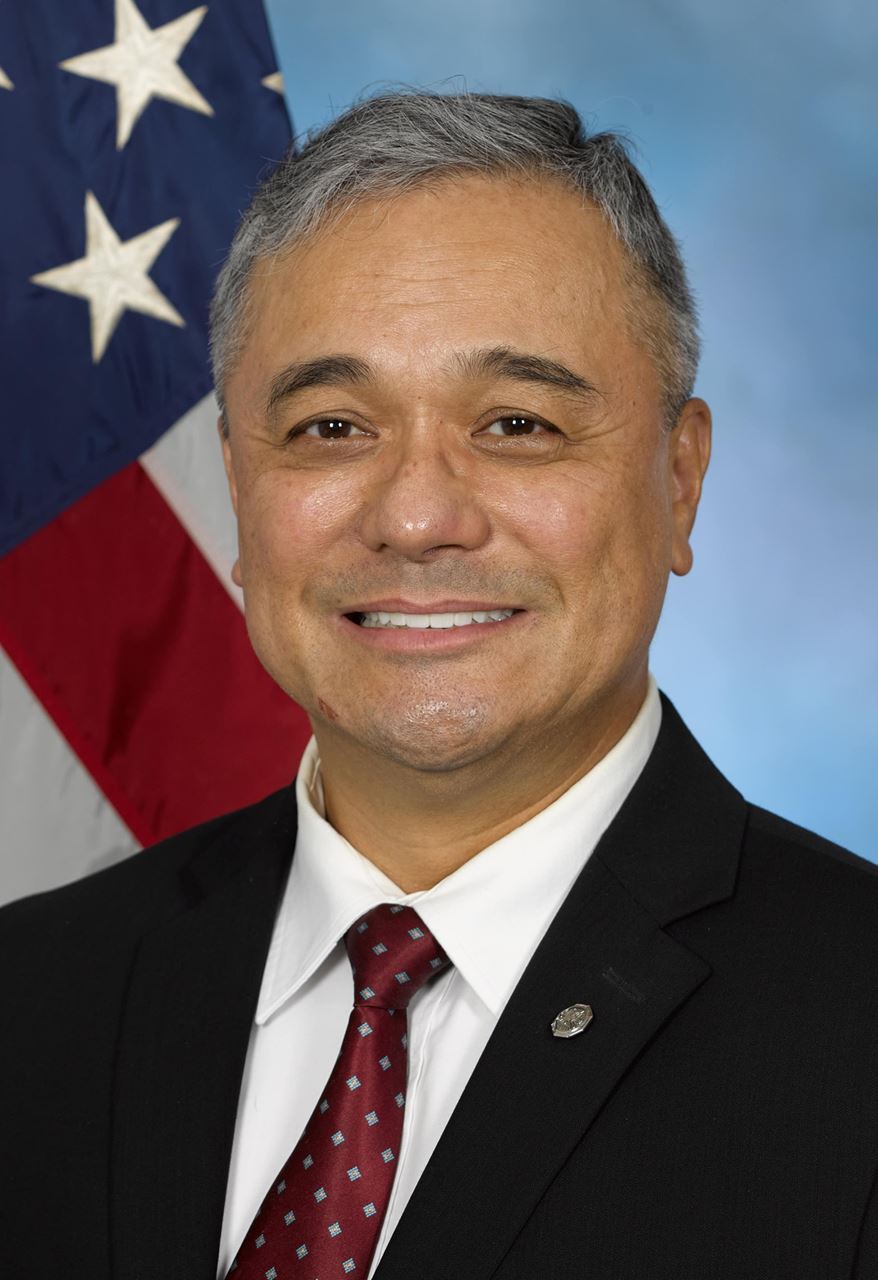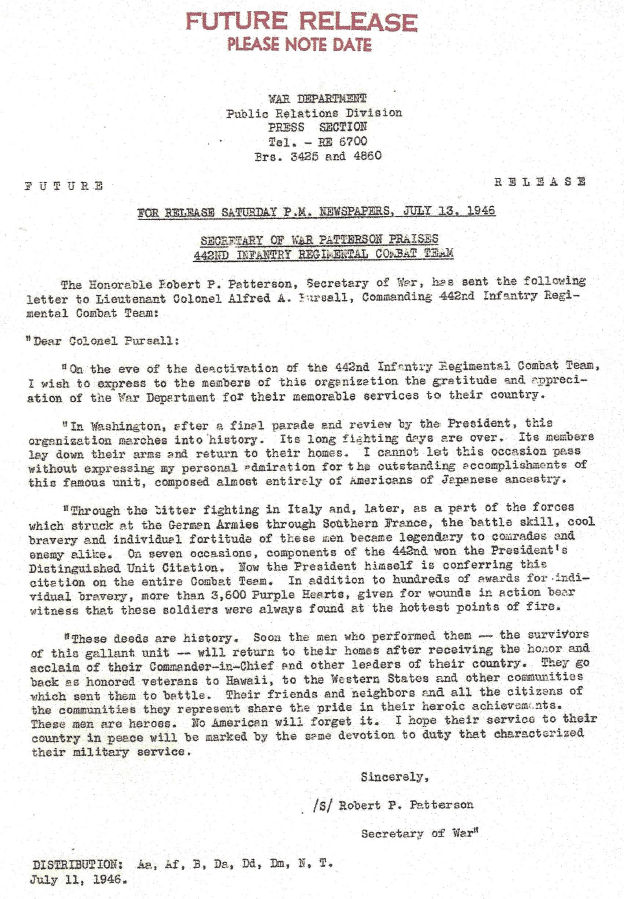JAPANESE AMERICAN VETERANS ASSOCIATION
 The Japanese American Veterans' Association, Inc. (JAVA), is a fraternal and educational organization with many purposes: Preserving and strengthening comradeship among its members; Perpetuating the memory and history of our departed comrades; Educating the American public on the Japanese American experience during WWII; and Striving to obtain for veterans the full benefit of their entitlements as veterans.
The Japanese American Veterans' Association, Inc. (JAVA), is a fraternal and educational organization with many purposes: Preserving and strengthening comradeship among its members; Perpetuating the memory and history of our departed comrades; Educating the American public on the Japanese American experience during WWII; and Striving to obtain for veterans the full benefit of their entitlements as veterans.
Read more ABOUT US.
President's Message
10 February 2024 - I am deeply honored to accept the presidency of the Japanese American Veterans Association. Your trust in me is a privilege, and I am committed to leading with the dedication and respect that this role demands. I extend my profound gratitude to all for your support and dedication. A special thanks goes to Gerald Yamada, whose exemplary leadership has significantly advanced our mission and inspired us all. Building on the strong foundation laid by Gerald and previous presidents, I aim to lead our organization to new heights, honoring the legacy of our veterans and supporting our members and communities. I am fortunate to work alongside an Executive Council of individuals marked by exceptional abilities, ethics, and dedication. Their commitment is our greatest asset as we pursue our goals. As we look forward, let us remain united and driven by our core principles of unity, service, and honor. I am eager to face our future challenges together, to celebrate our successes, and to continue making a meaningful difference. Thank you for this opportunity to serve. With integrity, openness, and tireless dedication, I pledge to uphold the values and mission of our association. Thank you. Howard High ____________________________________________________ NARA Archivist Locates Documentation for “Most Highly Decorated"
July 13, 1946 Press Release, "Secretary of War Patterson Praises 442nd Infantry Regimental Combat Team." Credit: National Archives and Records Administration. JAVA Research Team (JRT) Washington, DC. When speaking about the 100th Infantry Battalion, initially comprised of 1,400 Nisei draftees from Hawaii, and the 442nd Regimental Combat Team, comprised of 4,000 volunteers from Hawaii and the Mainland, speakers, writers, officials, press, and the public have referred to them as the most highly or one of the most highly decorated units in the United States Army. By its use, almost everyone, even the Chief of Staff of the U.S. Army, accepted this statement as fact. No one is known to have questioned its authenticity. JAVA speakers and writers have refrained, up to now, to make this statement because they did not want to face a questioner for documentation. For the past ten years, JRT has searched for the official origin of this “most highly decorated” statement at National Archives and Records Administration (NARA), U.S. Department of Defense and U.S. Army Public Relations Offices, U.S. Army Center for Military History, Library of Congress, Pacific Citizen, historians, and others with an absence of results. While not completely solved, the issue was virtually solved on August 16, 2021. Dr. Eric S. Van Slander, an archivist of NARA, College Park, MD, located a War Department Public Relations Division press release dated July 2, 1946, which said: “. . . 469 (442nd returnees for the Presidential review) have seen combat duty in an outfit that is one of the most highly decorated in the US Army”. While this citation is in a press release pertaining to preparations for the July 15, 1946, Presidential review of the 442nd, the statement confirms that it is owned by the War Department. JRT continues its search for a stand-alone statement and requests readers to advise the JAVA editor if such a document is located. With relation to this find, JRT wishes to present remarks made by then-MG Alfred M. Gruenther, U.S. Army, and share a letter from the U.S. Secretary of War to the 442nd commander, both of which support the most highly decorated statement. MG Alfred M. Gruenther, Commandant of the National War College and previously Chief of Staff of the U.S. Fifth Army, serving as the official representative of Secretary Patterson at the official welcome home ceremony at Camp Kilmer, NJ on June 11, 1946, told the returning 442nd men, including the 100th, "It was a great honor for me to be able to salute such a distinguished outfit. ...the 442nd's outstanding record of major decorations was unsurpassed by any other unit of comparable size." He enumerated the decorations and awards the unit had won and said that they are "the best evidence of your superb fighting qualities." The other is a letter from Secretary Patterson to LTC Alfred A. Purcell, 442nd Commander, dated July 11, 1946. Scans of the two press releases and other related documents can be read here. [EdNote: JAVA appreciates Dr. Van Slander, and the National Archives and Records Administration, for their continuing and exhaustive research.] | NOT A MEMBER YET?_____________________________________________________ _____________________________________________________ _____________________________________________________ Nisei Role as America’s “Eyes and Ears” Against Japan During War II and as a “Bridge” Between the Two Nations During the Occupation Visit JAVA Research Archive to read New Article on Role of MIS in WWII by Clicking Here.
_____________________________________________________
Nisei Proved Their Loyalty in WWII and did More. Sansei and Yonsei Built on Nisei Achievement.
President Truman reviews the 442nd RCT at the Ellipse, July 15, 1946. Photo: U.S. Signal Corps. JAVA Research Team (JRT), Terry Shima Washington, D.C. When Japan attacked Hawaii on December 7, 1941, the White House, War Department, U.S Congress, and the American public branded ethnic Japanese in the United States as spies and collaborators for Imperial Japan. Draft classification for Japanese Americans was changed to 4-C, alien, which banned them from enlisting in the U.S. armed forces. Nisei drafted before World War II and residing along the Pacific Coast states were discharged, those in the interior U.S. were given menial assignments such as cleaning latrines, and 1,432 Nisei draftees in the Hawaii Territorial Guard, later designated the 100th Infantry Battalion, were shipped to the mainland for training and deployment to Italy for combat. 120,000 ethnic Japanese, two-thirds of them U.S. citizens, were rounded up from the Pacific coast states on short notice and placed in internment camps guarded by sentries on the ground and in watch towers with machine guns. Separately, over 5,500 ethnic Japanese on the FBI suspect list were arrested and detained in camps run by the Department of Justice. Japanese Americans, individually and groups, petitioned the government to allow them to serve in combat to prove their loyalty. For this and other reasons, such as the superior combat training record of the 100th Battalion and the strong performance of Nisei linguists who volunteered for secret intelligence duty in the Asia Pacific Theater convinced Washington to form the 442nd Regimental Combat Team consisting of 4,000 Nisei volunteers from Hawaii and the mainland, many from internment camps. Many Nisei with college degrees volunteered because of JACL’s (Japanese American Citizens League) promise to help open the executive level job market then closed to Nisei. Finding jobs for Nisei graduates, many with advanced degrees, was a pressing concern for JACL’s Executive Secretary Mike Masaoka, during his final days in Italy before his discharge from the 442nd RCT. Three thousand Nisei volunteers, from Hawaii and the mainland, including many who studied in Japan, served in the Asia Pacific theater many in the combat zones fighting soldiers of their parents’ homeland. They translated captured documents, interrogated prisoners of war, intercepted enemy communications, prepared propaganda, and entered caves to persuade soldiers to surrender. Nisei served in the second or third wave of nearly every marine and infantry invasion to provide commanders tactical intelligence information in real time for counteraction, served in every unit which needed language support, in the special forces in Burma, in the caves of Yan’an, China interrogating Japanese captured by Chinese Communists. Each Nisei linguist in the Pacific combat zone was protected by a white bodyguard; each of them and white officers of the 100th Battalion and the 442nd RCT were instructed to report any evidence of Nisei disloyal acts. Another 3,000 Nisei linguists served in stateside assignments. Following training at Camp Shelby, Mississippi, the 442nd, minus the first battalion, was shipped to Italy where they merged with the 100th. While the 100th retained its unit designation, it served as the first battalion of the 442nd RCT. After one campaign in Italy, the 442nd RCT, including the 100th BN, was shipped to the Vosges Forests section of France to engage the Germans in the southern front of a two-front war. Displaying combat smarts, winning difficult battles assigned to them, and accepting assignments other units declined to handle, the 442nd RCT won the respect of their fellow white infantrymen and officers from other units. When so many combat commanders requested the assignment of the 442nd RCT to serve in their commands, the question of Nisei loyalty became a moot point. In addition to serving as riflemen and military intelligence, Nisei were sprinkled in small numbers in the U.S. Navy, U.S. Marines, U.S. Merchant Marines, WAC, Nurses Corps, and five who served as gunners in U.S. bombers flying into heavily armed German strongholds. According to the War Relocation Authority, 31,000 Japanese Americans served in uniform during WW II. Japanese Americans were the only ethnic group that went into combat during WWII to prove their loyalty. When War ended, no ethnic Japanese was convicted for collaborating with the enemy. No Nisei was court-martialed for desertion. Shortly after Germany surrendered, the War Department reportedly made two major widely publicized announcements, press releases of which are being sought:
It is my view that these two U.S. Army announcements validated Nisei loyalty. President Harry S. Truman reviewed the 442nd RCT on July 15, 1946, at the Ellipse, the outer south lawn of the White House. He told the Nisei, “You fought not only the enemy abroad, but you fought prejudice at home – and you have won. Keep up that fight and we will continue to win.” Through his remarks and personal review, Truman confirmed the Army’s validation of Nisei loyalty and removed from the table the stigma of ethnic Japanese disloyalty placed there when the war began. The first person known to the writer to make this observation was JAVA Vice President Colonel Vic Mukai, USA (Ret),around 2004. When WWII ended President Truman decided to reorganize the federal government “to equalize treatment and opportunities especially for African Americans” while also recognizing the special wartime contributions of other minorities, such as the Nisei, the Tuskegee Airmen, the Navajo Code Talkers, the Chinese American pilots who flew the Hump to deliver war material to China, and Filipino soldiers who served under General MacArthur’s command during WWII. These combined achievements served as the backdrop to Truman's Executive Order 9981 issued on July 26, 1948, two years after he reviewed the 442nd RCT. This landmark Executive Order, which desegregated the armed forces, said “There shall be equality of treatment and opportunity for all persons in the armed forces without regard to race, color, religion, or national origin.” This order leveled the playing field equally for all. Randy Sowell, an archivist at Truman Library observed that “the contributions of U.S. minority groups to the military effort in World War II contributed to the postwar movement to end discrimination against those groups in the armed forces and in U.S. society at large. President Truman was disturbed by reports of mistreatment of Black and Nisei veterans by civilians after the war.” JACL Executive Secretary Masaoka must have been pleased that his prayers were answered in E.O. 9981. Because of E.O. 9981, a few Nisei but predominantly Sansei and Yonsei, third and fourth-generation Japanese Americans, now would be found in all branches of service, in the cockpits of fighters and bombers as pilots, in the bridges of naval vessels, and in sensitive war planning staff positions. During WWII their assignments were limited to the U.S. Army and the highest Nisei rank was Major. Following the Vietnam War over 40 predominantly Sansei and Yonsei were promoted to generals and admirals with one, a Sansei, serving as Chief of Staff of the U.S. Army, a four-star position once held by General George C. Marshall. Over 80 other Asian Pacific Islanders, whose WWII performance also helped make E.O. 9981 happen, would also achieve flag rank. The civilian side, led by a few Nisei but predominantly Sansei and Yonsei, would witness similar breakthroughs. Thanks to the Nisei WWII endeavor, discriminatory laws were repealed, our alien parents were now permitted to become U.S. citizens; members of the US Congress, now confident of Nisei loyalty, passed the Hawaii statehood bill. The Commission of Wartime Relocation and Internment of Civilians, mandated by the U.S.Congress concluded that internment was not necessary, that it was caused by war hysteria, racial prejudice, and the failure of political leadership. President Reagan offered a formal apology for the internment. Nisei WWII soldiers received the Congressional Gold Medal, the highest honor the U.S. Congress can bestow. Additionally, Senators selected a Japanese American to serve as president pro tempore of the U.S. Senate, a position, that constitutionally put Senator Daniel Inouye third in line for the Presidency. Sansei and Yonsei remain vigilant to defeat racism executed against Asian and non-Asian minority groups. The Nisei, Sansei, and Yonsei story speaks to the Greatness of America. God Bless the USA. [EdNote. Terry Shima, 442nd Public Relations, joined JAVA around the year 2000, served as Executive Director from 2004 – 2012, and has since served on the Board of Directors, in committees -- all the while studying the ethnic Japanese issues during WWII. He continues to be interviewed for the press and TV. We have asked Terry to write an article on the loyalty issue: did the Nisei achieve their loyalty goal of WWII and how did the post-WWII generations acquit themselves? If your views are at variance or in accord with Terry Shima’s we would be pleased to hear from you.] ____________________________________  JAVA Member and 442nd Veteran, Terry Shima Speaks about the Japanese American Experience During World War II Recently the Keese School Lecture Series featured former JAVA Executive Director and JAVA Terry Shima as a speaker at their continuing education series. By way of introduction it was noted that Terry was born and raised in Hawaii. He was drafted in to Army in 1944 and served in the 442nd RCT. After the war, Terry attended and graduated from Georgetown University's School of Foreign Service and enjoyed a 30-year career in the Foreign Service with postings in the Philippines, Singapore and Vietnam. In 2012, President Obama awarded Terry the Presidential Citizens Medal. After leaving his official post as Executive Director of JAVA, he has continued to support the research and publication of the Advocate and e-Advocate. In the video Terry explains the origins of the 100th Battalion, 442nd Regimental Combat Team and MIS and highlights examples of Japanese American soldiers bravery and valor in an effort to prove their loyalty to the U.S. Click here and use the password "avtv" to watch.
_____________________________________________________
|




